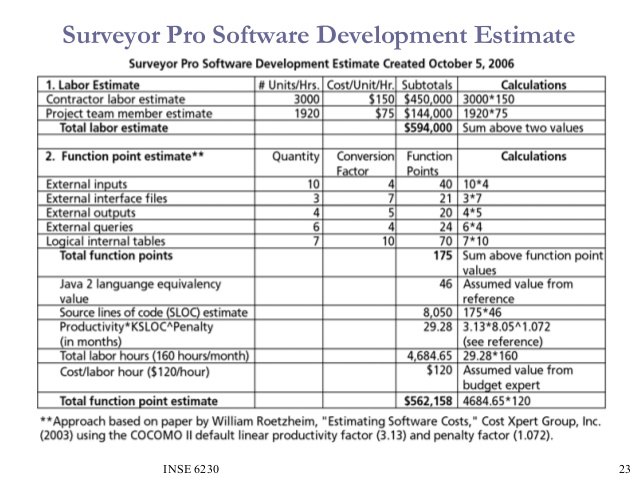
How to Estimate Software Development Time: Techniques & Methods
Wondering how to estimate software development time?
Look no further as we will discuss different methods and techniques for it here.
“The primary purpose of software estimation is not to predict a project‘s outcome; it is to determine whether a project‘s targets are realistic to allow the project to be controlled to meet them”- Steve McConnell (Leading author on software engineering).
Do we overvalue the importance of software development time estimation?
The simple answer to this question is a resounding no. Project estimation is one of the most important aspects of the project. Without it, developers and companies would effectively be going in blind, with very little in the way of expectations, timelines, costs, or goals to guide them.
So, first, let's see why would you need to estimate the software development time for your project.

Get a complimentary discovery call and a free ballpark estimate for your project
Trusted by 100x of startups and companies like
Main reasons why we need to estimate software development time for projects:
You will estimate software development time for the following:
- To understand what the project is;
- To build a clear understanding of the project requirements;
- Establish timeframes for completion;
- Effectively budget the project;
- Allow clients to give developers clear targets;
- Allow developers to give clients clear expectations;
- Ensure staffing is adequate and that staff are all working on the same page;
- To ensure all the necessary resources are on hand to complete the project;
- Risk assessments and to help to plan for problems;
- Sets up realistic expectations with management/client.
The real question is not whether we overvalue the importance of project estimation, but rather why we can‘t estimate software development time more accurately.
Projects that are seen to run grossly over budget affect both outside perceptions relating to the professionalism of a company or organization, while also causing budgetary problems that in the past have actually destroyed companies.
The list of projects that have ended up killing their parent company, or at least putting them heavily into debt, is endless.
Since companies are more accountable for their failures which can result in them going out of business, being taken over, or at least operating at a loss, we tend to focus our frustrations on government projects that vastly overrun their budgets, particularly as they are wasting enormous sums of tax payers‘ money rather than their own.
One only needs to think of the new F35 project, where according to Time Magazine, total costs are now estimated as being “$395.7 billion, an increase of $117.2 billion (42 percent) from the prior 2007 baseline”. To put this underestimation in perspective, $400 is around 3% of the U.S. GDP, which works out to about $1150 per person in the country. Feel slightly annoyed? I do!
So, how to create a project estimation to accurately estimate software development time? Let's see next.
How to create an accurate project estimation:
You will do the following to realistically estimate software development time:
1. Use a basic project planning template to outline a description of your project
Someone once said to me “An idea is worth nothing, it‘s making it happen that turns it into gold”. It might seem strange to have to sit down to write out a detailed description of what your project is and how it will work, but this is the first important step in ensuring the project‘s success.
I can‘t tell you how many times I‘ve been involved in a new project when I‘ve asked a simple question like, “What is your target demographic?”, for example, only to receive a baffled look from the client.
The answer to this question will affect everything from the interface design to the marketing strategy, so needs to be considered when writing the project description.
This basic plan should allow you to visualize the software in three dimensions, including the types of people using it, potential revenue streams, staffing, etc.
If you are still unsure and need a good project planning template then you can contact our support team to request one free of charge!
2. Evaluate your team‘s expertise
This is one of the most overlooked aspects of project planning. If your team doesn‘t have sufficient experience/expertise or is understaffed, for example, then your project is almost certainly going to run into problems that will lead to overruns, etc.
Your team should include developers who have enough experience that they are able to look at your project‘s features and are able to accurately evaluate time-frames, costs, potential problems, etc.
1,200 top developers
us since 2016
Experienced developers will have the added bonus of being able to refer to past projects where they have developed similar features, therefore, making their software development estimates more accurate.
If you don‘t have the experienced in-house staff your project requires, then you should employ the help of an outside developer.
3. Communication is the key to the entire project‘s success
Software development estimation is a collaborative effort. In order to estimate projects, it really pays to involve each member of the team (where their skills might be relevant). This includes asking for the same information from several different team members at once.
Not only will this ensure the accuracy of the information but it will also initiate a healthy communication process within the team too.
As part of DevTeamSpace‘s refined project development methodology, we employ numerous tools to encourage a good level of communication between team members. We use dashboards, open project conversations through Slack, and hold regular standup calls to update and involve team members more thoroughly.
Remember that full team collaboration is essential to avoid those ’I thought you were doing that‘ moments that cause project delays. Finally, no team member should ever be made to feel afraid of coming forward with a query or problem.
Problem reporting is one of the key aspects of damage control and should be dealt with quickly and efficiently.
4. Employ a Work Breakdown Structure (WBS)
The easiest way to estimate time-frames, man-hours, costing, etc. is to break the project into smaller pieces, otherwise known as a work breakdown structure.
So, let‘s say your project has a complex interface, a payment system, and a member‘s section, then these can be estimated separately to make the task more manageable. You will need to take into account how your project fits together, however, as these functions will inevitably overlap in some way.
During this process, you should clearly define what hardware, software, human resources, and money needs to be allocated to each stage. The work breakdown structure approach allows for far more detail to be developed from the initial plan by facilitating a question/answer cycle that gives a far more in-depth understanding of the project.
5. Build in room for adjustments/overruns when estimating software development time
When estimating time for your estimate software development project it pays to build in safety margins for unforeseen problems.
Understandably, most developers want to give a low cost/time estimate (particularly if they are an outside custom software development company trying to win the contract), but this is wrong. Personally, I build a 10% to 20% safety margin for both cost and the timeframe for the completion of the whole project.
This allows for problems to be easily dealt with within the agreed timeframe and budget, and in most cases, saves those awkward moments when you must ask your managers/client for more time and money.
6. Use clear tables/flow diagrams/illustrations when finalizing your software project estimate
The final version of your project estimate should be clear and easy to understand. Again, this seems obvious but you would be amazed how many poorly presented estimates I‘ve seen in my time.
Cost breakdowns should be presented in a way similar to the following example document (with obvious adjustments to suit your project specifics):
IT project cost estimation template sample
The final stage of the (non-revised) project estimate is to present it to the management/client in a clear understandable manner that sets up realistic expectations. Management should be guided through each step of the development so that they have a good understanding of the whole development process.
A few things are vital when presenting the estimate; firstly they should be made aware that this is only a provisional estimate as the project is likely to evolve as it goes on. Secondly, they should be made aware that the costing/timeline to completion includes a 10-20% overhead to factor in potential overruns.
It is during this time that you should agree with them on a set of procedures in case the circumstances should change.
Key questions such as “how much do they want to know about project revisions?”, “When do they want to know it?”, “how involved in the decision-making process do they want to be?” etc. should all be answered before the project begins. These are crucial if you want to estimate projects effectively.
Key project estimation techniques to remember:
- No estimation is set in stone, things can and will change.
- Be flexible.
- Use a suitable project planning template that includes a clear description, project objectives, screens, features list, etc.
- Break the project down into sizable sprints/stages.
- Allow for testing time with suitable resources after every sprint.
- Ensure all steps/processes are discussed and agreed upon with the client.
- Overestimate the project‘s budget by roughly 10 - 20% (depending on complexity) and tell the client the reasons you have done so.
- Don‘t fall into the trap of thinking that an overestimation will make you look incompetent.
- Ensure good communication with the client regarding the project‘s progress.
- Always get second opinions including getting an independent party to review your estimate.
- After commencing the project, remember to refine estimates as soon as new information is available.
Summing up Why and How to Estimate Software Development Time
The way that all professionals go about producing a project estimation should be fundamentally the same.
While it is certainly the case that developers who have lots of experience will be able to produce one in a much quicker time, without compromising accuracy, the key is not to overlook the importance of good project estimation.
I deliberately didn‘t cover some aspects of the theory regarding project estimation, simply because it is available from so many other sources, including this good summary of Software Development Effort Estimation.
Two further pieces that discuss how to make accurate estimates for enterprise software projects in great detail are The Dark Art of Project Estimation and Software Project Estimation by Kathleen Peters.
Should you require experienced software engineers for accurate project estimation, DevTeam.Space can help you with its field-expert software developers and project managers community experienced in deploying market-competitive software products for a range of industries.
You can easily partner with these vetted software developers for your next software development projects by writing to us your initial software product specifications, and one of our account managers will get in touch with you for project planning, software development team building, project management, etc.
Frequently Asked Questions
Inside and out understanding of the project scope, the work hours required and cost per hour of each skillset, the infrastructure required, and the timeframe of completion.
Magnitude estimate
Budget estimate
Definitive estimate
Number of workers x Hours worked per week x Expected number of hours to complete = Project Hours


